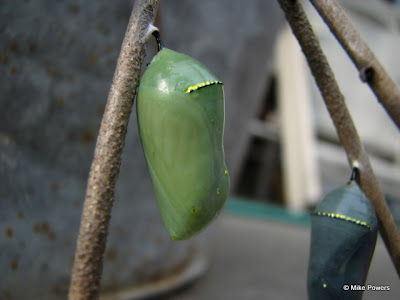Our remaining Spicebush Swallowtail (Papilio troilus) chrysalis remains a Spicebush Swallowtail chrysalis. As I wrote in an earlier posts (linked above), some swallowtail caterpillars will emerge the same year, some overwinter and emerge the following spring.
Monarchs (Danaus plexippus) typically hatch some 9 - 14 days after forming a chrysalis.When the three caterpillars pupated on three successive days we expected three straight days of butterfly emergence.
 Different rates of development: the youngest chrysalis (center) is still a
Different rates of development: the youngest chrysalis (center) is still alight green, the oldest (right) is dark. Look close, the butterfly is visible inside.
Yes, I made my daughter get all science-geeky with me. We got a calendar and marked off which dates each caterpillar (Rosemary, Kee, and Skinloser) formed a chrysalis. Next we counted off the earliest and latest expected emergence dates.
 The second-oldest chrysalis is as dark as the oldest, you can also
The second-oldest chrysalis is as dark as the oldest, you can alsosee the butterfly inside. The caterpillar skin stuck to the chrysalis.
We discovered the expected emergence dates fell after school started, not a great situation if it happened while no one was home. Reina brought them to school for an extended show-and-tell, then they came home for the weekend.
Sunday afternoon two of the chrysalids were deep, dark green, but also transparent: you could see the butterfly inside (click on the images for a larger image). We'd read that was a sure sign they'd be emerging in the next 24 hours. We were happy they held on for the school week to begin so the students could witness the event.
 I have no idea what function that alien-like pattern on
I have no idea what function that alien-like pattern onthe chrysalis performs, is that where it will split? The
caterpillar skin sticks to the side of the chrysalis.
Seven-o'-clock Monday morning I came downstairs and immediately noticed a chrysalis was cracked open and a boldly colored Monarch was hanging from the branch - not a bad pre-coffee observation for me. Reina came over and pointed out there were two Monarchs, highlighting that my pre-coffee observation skills are questionable.
 The older butterfly (Rosemary) took off as soon as we
The older butterfly (Rosemary) took off as soon as weuncovered the vase, landing in a nearby oak. Kee,
the second oldest, rested on Reina's finger for awhile.
One butterfly started slowly flexing its wings. Afraid it would damage itself by rubbing the wing on the branch we decided we had to release them before we got to school.
 Eventually Kee rested on a Trumpet Creeper - sheltered
Eventually Kee rested on a Trumpet Creeper - shelteredfrom view and the remnants of Hurricane Ike. After a
rest she'll be off, Monarch migration is underway!
Happily there is still one to go, by my estimation it will emerge Tuesday or Wednesday at the latest, and hopefully after 9:00 AM when the kids are there. Look close on the following image and you'll see the wings.

For the scientific minded, 13.5 days from chrysalis formation to butterfly emergence (n=2).
-



3 comments:
Very cool little project. Beautiful pictures and beautiful butterflies.
What a fun activity to share with your daughter!
Hi sparverius and zen birdfeeder!
It started as a whim when we first spotted caterpillars, and I'm thinking we're going to do even more next year. I'm glad it's really turned Reina on to discovering and exploring the nature in our backyard and local nature centers.
I'm looking forward to putting the bird feeders out again and figuring out equally fun activities to do with counting birds. Keep reading for more!
-Mike
Post a Comment